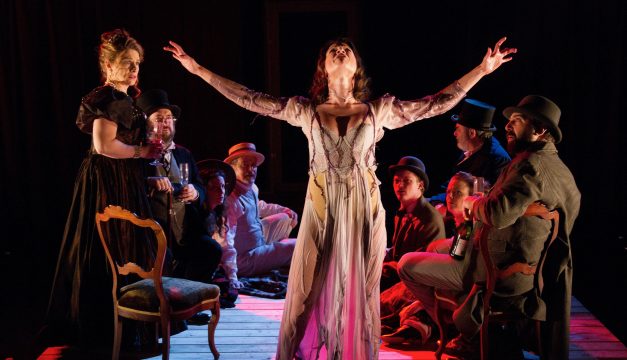THEATER REVIEW: Magic by the Lake in EgoPo’s The Seagull

Anna Zaida Szapiro and the Cast of The Seagull at EgoPo. (Photo by Dave Sarrafian)
You can count on EgoPo artistic director Lane Savadove for interesting ideas, and there some knockouts in his provocative take on The Seagull. The trouble is I can’t say too much for fear of spoiling the fun. You need to discover it yourself. (And indeed, you should buy tickets immediately—this reimagining of Chekhov will blow your mind.)
But I will say that from the moment you enter, you’ll be immersed in the world of the theater, or perhaps I mean worlds: Savadove’s The Seagull, of course—but also the play-within-a-play by poor Konstantin, who wants so desperately to be a great writer (Andrew Carroll gives a touchingly fragile performance). Watching from Thom Weaver’s gorgeous, you-are-there lakeside summer house setting, I’ve never felt more poignantly the scope of Konstantin’s dreamy ambition… and the pain of his failure.
Konstantin is the lens through which we see much of the action here, and it’s appropriate because so much of The Seagull is about the painful gulf between aspiration and reality that all artists fear. Among the characters, we have writers and actresses, veterans and beginners, all of them grappling with their demons. (In characteristically sly fashion, Chekhov leaves open the possibility that none of these people have much actual talent.) And, again because it’s Chekhov, it’s also a story of romantic misconnections among a motley, emotionally vulnerable assemblage—A wants B, B wants, C, and so on. Love and art—that’s what The Seagull is all about.
It’s axiomatic that the great Chekhov plays, usually described as comedies, mix humor and melancholy. What’s unusual in Savadove’s Seagull is how much the emphasis is on funny—and how illuminating it is.
One example among many—the big scene between Arkadina, the older actress, and her younger boyfriend, the writer Trigorin (who in turn is drawn to the much younger Nina). This moment of desperation can be almost too painful to watch. Here, though, Melanie Julian is a boisterous, slightly vulgar Arkadina who is clearly comfortable as the sexual aggressor; and Ed Swidey is a self-centered, schnooky Trigorin, far less Byronic than usual. Both actors are terrific, and the scene takes on an awkward humor—but it’s also still sad. Julian’s quirky Arkadina was a particular revelation for me. I’m used to thinking of the character as a Grande Dame, and indeed it’s often seen as Chekhov’s love letter to great actresses of a certain age. Here, I realized that while Arkadina may imagine herself as a major leading lady, her real theater “type” is Funny Best Friend—she’s the classic seconda donna who dreams, unrealistically, of being star.
Over and over, Savadove provides rethought moments like this, and I like some better than others. His program notes consider The Seagull as naturalism, symbolism, and expressionism. That’s a lot of “isms,” and I don’t agree with all of them. Late in the play, another knockout idea is likely to thrill some viewers and alienate others. I’m in-between, but I will say that (like all of the show) it’s visually stunning and will keep you thinking. There’s lovely ensemble acting from Aaron Cromie, Stephanie Iozzia, Kirsten Quinn, Eric Kramer, and the hilarious Mark Knight; and a sensational performance by Anna Zaida Szapiro as Nina—less ethereal than the usual take, and all the more heartbreaking for her real-girl-ness.
I can’t guarantee that you’ll love everything about EgoPo’s The Seagull, but I can promise something even more important—you’ll be thinking a lot about it afterward. As I am.
The Seagull plays through February 19. For more information, visits the EgoPo Classic Theater website.


